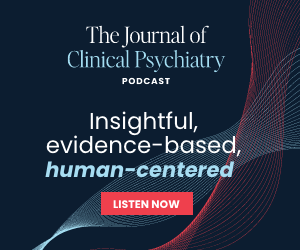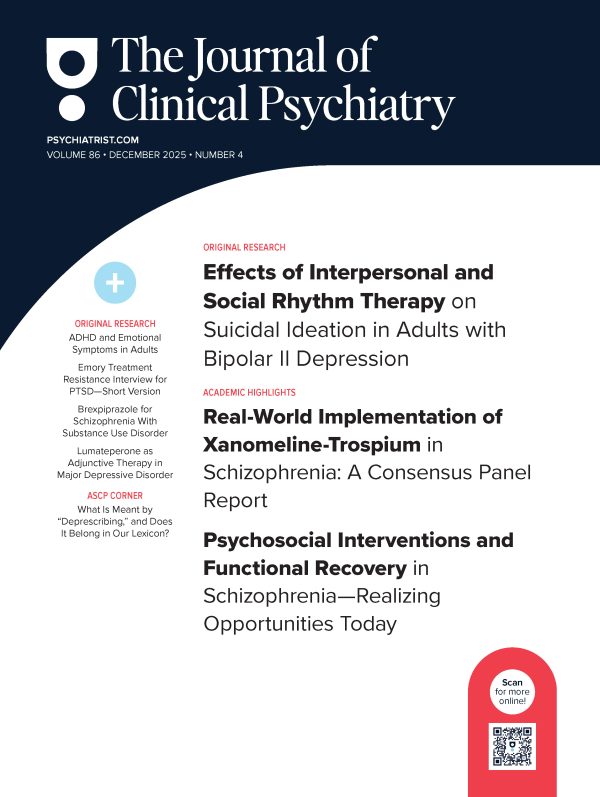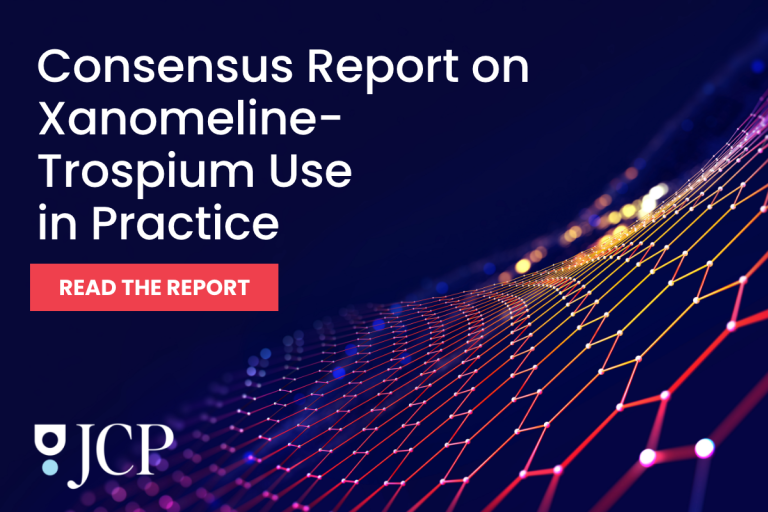ABSTRACT
Background: The prevalence of treatment-resistant depression (TRD) among patients with pharmaceutically treated depression (PTD) varies greatly in publications. The aim of this study is to estimate the prevalence of TRD using 2 large claims databases in the US.
Methods: This cross-sectional study used data from the Humana and Optum databases. Patients aged ≥ 18 years who had at least 1 diagnosis of major depressive disorder (ICD-10–CM codes: F32.xx, F33.xx) and 1 antidepressant prescription filled in 2018 were identified as having PTD. Among patients with PTD, TRD was defined as experiencing failure of treatment with at least 2 antidepressants with ≥ 4 weeks of adequate treatment. We estimated the age- and gender-standardized prevalence of TRD and then used logistic regression to investigate if TRD risk varies by age, sex, race, and geographic region. Finally, we described the timeline of TRD development in incident PTD patients.
Results: We identified 296,055 and 277,941 patients with PTD in the Humana and Optum databases, among whom 17,640 (6.0%) and 16,131 (5.8%) had TRD. After age and sex standardization, TRD prevalence among PTD patients was 6.8% in Humana vs 5.8% in Optum. Females, middle-aged adults, and White patients had higher risk of TRD. The median time from index antidepressant use to TRD was about 6 months in incident PTD patients.
Conclusions: The prevalence of TRD among patients with PTD was similar in the 2 databases. TRD prevalence varies by sex, race, and age, with a higher prevalence in females, White patients, and those in the age group of 45–64 years. However, the absolute differences were small.
Members Only Content
This full article is available exclusively to Professional tier members. Subscribe now to unlock the HTML version and gain unlimited access to our entire library plus all PDFs. If you’re already a subscriber, please log in below to continue reading.
References (35)

- Brody DJ, Pratt LA, Hughes JP. Prevalence of depression among adults aged 20 and over: United States, 2013–2016. NCHS Data Brief. 2018;303:1–8. PubMed
- Ionescu DF, Rosenbaum JF, Alpert JE. Pharmacological approaches to the challenge of treatment-resistant depression. Dialogues Clin Neurosci. 2015;17(2):111–126. PubMed CrossRef
- Thomas L, Kessler D, Campbell J, et al. Prevalence of treatment-resistant depression in primary care: cross-sectional data. Br J Gen Pract. 2013;63(617):e852–e858. PubMed CrossRef
- Preskorn SH. Prediction of individual response to antidepressants and antipsychotics: an integrated concept. Dialogues Clin Neurosci. 2014;16(4):545–554. PubMed CrossRef
- Fife D, Reps J, Cepeda MS, et al. Treatment resistant depression incidence estimates from studies of health insurance databases depend strongly on the details of the operating definition. Heliyon. 2018;4(7):e00707. PubMed CrossRef
- Olfson M, Amos TB, Benson C, et al. Prospective service use and health care costs of Medicaid beneficiaries with treatment-resistant depression. J Manag Care Spec Pharm. 2018;24(3):226–236. PubMed CrossRef
- Nemeroff CB. Prevalence and management of treatment-resistant depression. J Clin Psychiatry. 2007;68(suppl 8):17–25. PubMed
- Gaynes BN, Gartlehner G, Hoffman V, et al. Definition of Treatment-Resistant Depression in the Medicare Population. Technology Assessment Program. Rockville, MD: Agency for Healthcare Research and Quality; 2018.
- Li G, Fife D, Wang G, et al. All-cause mortality in patients with treatment-resistant depression: a cohort study in the US population. Ann Gen Psychiatry. 2019;18(1):23. PubMed CrossRef
- Waldo DR. Accuracy and bias of race/ethnicity codes in the Medicare enrollment database. Health Care Financ Rev. 2004;26(2):61–72. PubMed
- Polubriaginof FCG, Ryan P, Salmasian H, et al. Challenges with quality of race and ethnicity data in observational databases. J Am Med Inform Assoc. 2019;26(8-9):730–736. PubMed CrossRef
- Fife D, Feng Y, Wang MY, et al. Epidemiology of pharmaceutically treated depression and treatment resistant depression in Taiwan. Psychiatry Res. 2017;252:277–283. PubMed CrossRef
- Trevino K, McClintock SM, McDonald Fischer N, et al. Defining treatment-resistant depression: a comprehensive review of the literature. Ann Clin Psychiatry. 2014;26(3):222–232. PubMed
- Demyttenaere K, Van Duppen Z. The impact of (the concept of) treatment-resistant depression: an opinion review. Int J Neuropsychopharmacol. 2019;22(2):85–92. PubMed CrossRef
- Bains NAS. Major Depressive Disorder. NCBI. https://www.ncbi.nlm.nih.gov/books/NBK559078/. Accessed Oct 19, 2020.
- Kubitz N, Mehra M, Potluri RC, et al. Characterization of treatment resistant depression episodes in a cohort of patients from a US commercial claims database. PLoS One. 2013;8(10):e76882. PubMed CrossRef
- Nuggerud-Galeas S, Sáez-Benito Suescun L, Berenguer Torrijo N, et al. Analysis of depressive episodes, their recurrence and pharmacologic treatment in primary care patients: a retrospective descriptive study. PLoS One. 2020;15(5):e0233454. PubMed CrossRef
- Machado-Vieira R, Baumann J, Wheeler-Castillo C, et al. The timing of antidepressant effects: a comparison of diverse pharmacological and somatic treatments. Pharmaceuticals (Basel). 2010;3(1):19–41. PubMed CrossRef
- Katon W. Collaborative depression care models: from development to dissemination. Am J Prev Med. 2012;42(5):550–552. PubMed CrossRef
- Culpepper L. Misdiagnosis of bipolar depression in primary care practices. J Clin Psychiatry. 2014;75(3):e05. PubMed CrossRef
- Madigan D, Ryan PB, Schuemie M, et al. Evaluating the impact of database heterogeneity on observational study results. Am J Epidemiol. 2013;178(4):645–651. PubMed CrossRef
- Zimmerman M, Posternak M, Friedman M, et al. Which factors influence psychiatrists’ selection of antidepressants? Am J Psychiatry. 2004;161(7):1285–1289. PubMed CrossRef
- De Carlo V, Calati R, Serretti A. Socio-demographic and clinical predictors of non-response/non-remission in treatment resistant depressed patients: a systematic review. Psychiatry Res. 2016;240:421–430. PubMed CrossRef
- Petersen T, Hughes M, Papakostas GI, et al. Treatment-resistant depression and Axis II comorbidity. Psychother Psychosom. 2002;71(5):269–274. PubMed CrossRef
- Sagud M, Mihaljevic-Peles A, Uzun S, et al. The lack of association between components of metabolic syndrome and treatment resistance in depression. Psychopharmacology (Berl). 2013;230(1):15–21. PubMed CrossRef
- Bergman J, Miodownik C, Palatnik A, et al. Efficacy of bupropion XR in treatment-resistant elderly patients: a case series study. Clin Neuropharmacol. 2011;34(1):17–20. PubMed CrossRef
- Cepeda MS, Reps J, Ryan P. Finding factors that predict treatment-resistant depression: results of a cohort study. Depress Anxiety. 2018;35(7):668–673. PubMed CrossRef
- Gerhard T, Stroup TS, Correll CU, et al. Antipsychotic medication treatment patterns in adult depression. J Clin Psychiatry. 2018;79(2):55–61. PubMed CrossRef
- Hinton L, Zweifach M, Oishi S, et al. Gender disparities in the treatment of late-life depression: qualitative and quantitative findings from the IMPACT trial. Am J Geriatr Psychiatry. 2006;14(10):884–892. PubMed CrossRef
- Burnett-Zeigler I, Kim HM, Chiang C, et al. The association between race and gender, treatment attitudes, and antidepressant treatment adherence. Int J Geriatr Psychiatry. 2014;29(2):169–177. PubMed CrossRef
- Bogner H, Dobransky LN, Wittink MN. Patient ethnicity and perceptions of families and friends regarding depression treatment. Ethn Health. 2008;13(5):465–478. PubMed CrossRef
- Alegría M, Chatterji P, Wells K, et al. Disparity in depression treatment among racial and ethnic minority populations in the United States. Psychiatr Serv. 2008;59(11):1264–1272. PubMed CrossRef
- King M, Essick C. The geography of antidepressant, antipsychotic, and stimulant utilization in the United States. Health Place. 2013;20:32–38. PubMed CrossRef
- Columbo JA, Stone DH, Goodney PP, et al. The prevalence and regional variation of major depressive disorder among patients with peripheral arterial disease in the Medicare population. Vasc Endovascular Surg. 2016;50(4):235–240. PubMed CrossRef
- Wang J, Wu X, Lai W, et al. Prevalence of depression and depressive symptoms among outpatients: a systematic review and meta-analysis. BMJ Open. 2017;7(8):e017173. PubMed CrossRef





